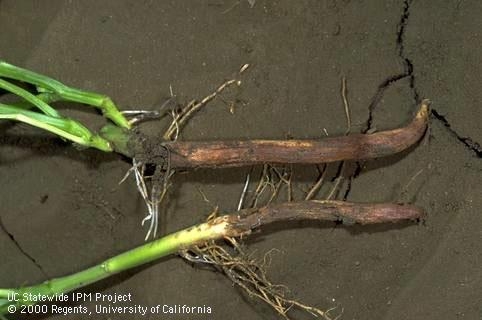I recently visited a bean field in the southern part of the county with a PCA. From a distance, the beans in certain areas of the field appeared to be drying up and dying. A closer look showed that the leaf margins were drying up first before the whole plants declined. Pulling up plants by the roots, they appeared to show some reddish root lesions. Soil moisture was good – it seemed neither too wet nor too dry, but there was white crusting on the soil surface of the furrows.
As I was thinking about what could be happening with the beans, a couple things were running through my mind. The patchiness of the problem in the field and the reddish roots made me think that Fusarium root rot (Figure 1) may be a problem. The PCA believed that there had been tomatoes in the field the previous year but that there may have been beans in the field just two years ago. I wondered whether the white crusting on the soil was due to salt. The PCA said that he thought the field was irrigated with groundwater.
To put something behind my hunch, I sent plant samples up to the disease diagnostics lab at UC Davis. Tests confirmed that both Fusarium and Rhizoctonia inoculum were present on the plant roots and that the Fusarium inoculum was particularly high. Fusarium spores can survive in the soil for several years, and UC IPM guidelines suggest rotating out of beans for at least three years in Fusarium-affected fields. Unfortunately, Fusarium spores will live in the soil even when bean hosts are not present.
Stress conditions in the field can worsen Fusarium infection, particularly conditions of too much or too little water, compaction, and salinity. We tested the soil salinity at this site and found the electrical conductivity (EC) of the surface soil to be around 5.0 decisiemens per meter (dS/m). Beans are very sensitive to salinity, and yield declines are expected when rootzone soil salinity is as low as 1.0 decisiemens/meter. It would appear that salinity could be stressing the beans and causing them to be more susceptible to the Fusarium inoculum in the soil. Because this grower is irrigating with groundwater, I would recommend that he get his water tested for salinity. If the water salinity is acceptable, then he should consider how he will leach the field this winter, perhaps augmenting rainwater with irrigation water (assuming normal-to-low precipitation this winter). If his groundwater is high in salts, then he should consider using a different water source for irrigating and leaching (if available) and rotate to more salt-tolerant crops, like small grains, for at least three years.